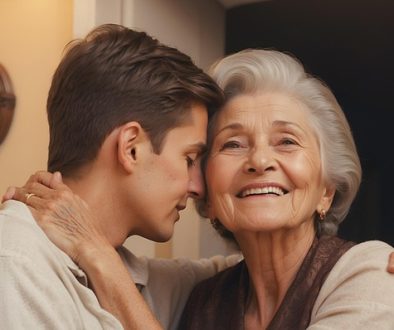Is Aging at Home the Right Choice for Your Loved One?
We know aging at home is the most comfortable and desirable option.
“Mom is just so comfortable at home. She has all of her pictures and memories of raising our beautiful family there.” Or “Dad built that home. That type of craftsmanship just doesn’t exist anymore. He could never leave that behind.”
Aging at home is a powerful draw and a natural preference. A home carries the spirit of families, built on a foundation of love. It arouses memories and brings comfort even at end of life when pain and emotional stress can be most profound (for everyone). But is it the best choice for your loved one to live out the rest of their days?
Sometimes it’s possible, but a Stanford School of Medicine study found roughly 80 percent of Americans ultimately pass away in acute-care hospitals or nursing homes. Sometimes it’s just not feasible, even though 3 in 4 aging adults prefer to remain at home, according to AARP.
But independent living is a noble goal. Let’s strive for it! Let’s keep your elders at home as long (and as safely) as possible with some person-centered care.
Aging at Home: A Plan for Quality of Life
Here are a few considerations:
Avoiding Falls
Falls are the leading cause of injury for senior citizens. Roughly 70 percent of elder falls happen in the home, according to the National Safety Council. While it’s natural for aging individuals to see declines in strength, coordination, vision and other things that keep folks firmly planted on their feet, the physical environment at home contributes to great numbers of falls.
Fewer than 1 in 3 seniors recover fully from broken bones — hips especially — to pre-injury strength, according to the Journal of General Internal Medicine. Many who suffer such injuries remain permanently in nursing homes and assisted-living facilities.
So what can care-partner teams do to prevent falls? Let’s scan the environment:
- Declutter – Small objects like power cords, area rugs, children’s/animal toys, etc. in walking paths are major tripping hazards. Make sure paths are cleared regularly and that frays from rugs or carpeting are removed or smoothed out.
- Better lighting – Seeing in dark or dimly lit spaces gets more difficult with age. Make sure all lights and lamps have bright, new bulbs in common areas. Walking paths (like hallways to bathrooms and bedrooms) also should be well-lit.
- Walking safely – Some elders may require a cane or walker to move about the house. Non-slip footwear also can be very helpful.
- Stability bars – Some areas, particularly in bathrooms where individuals may frequently stoop or sit, may require stability bars for extra support.
- Furniture placement – While your loved one’s furniture arrangement may not have changed in decades, it’s smart to rearrange furniture in a configuration that allows the most unobstructed walking space.
Of course, falls are never 100 percent preventable with age. Consider using a medical-alert bracelet or necklace for prompt emergency response to stumbles while home alone.
Building Strength
Even the strongest and healthiest elders may fall and get injured. But it’s much less likely if their bodies and minds are in the best shape possible. A light exercise or supervised physical therapy regimen can build strength, coordination and balance.
There are numerous exercises even for novices or those in poor physical condition. A brief 15-minute walk down the sidewalk each night is among the easiest of fitness routines, but it carries some of the greatest benefits. Exercise doesn’t build only muscular strength. Done correctly and in combination with proper diet, it may also improve:
- Flexibility
- Joint health
- Cardiovascular health
- Neurological conditions
It also improves confidence. A strong and confident gait is always better than a weak and uncertain shuffle. Consult a primary care physician or licensed physical therapist to develop a fitness regimen for specific needs. (Helpful hint: A person-centered care approach should always consider your loved one’s individual strengths, weaknesses, wants and personal fitness goals. Forcing a “tried-and-true” or “one-size-fits-all” therapy approach is often counterintuitive to strength improvements.)
A Helping Hand
Independent living doesn’t mean living without help. Your elder(s) may live at home for several decades beyond retirement in great health. Or poor health (physical, mental and/or emotional) may set in much sooner. Physical and cognitive abilities, memory, and judgment may decline naturally with age. But such regressions often don’t merit changing living arrangements.
Rather, your loved one(s) likely just needs a helping hand. The scope of this assistance may vary person to person over time. An elder may at first need only brief, periodic visits to help with cleaning or putting away groceries. With time, they may require more frequent assistance with wide-ranging tasks including:
- Bathing
- Cooking and cleaning
- Community living and activities
- Legal and finances
- Medications
- Preparation for bed
Your loved one(s) may still take an active role in most, if not all, of these tasks. But frequent assistance (or 24/7 supervision in cases of advancing forms of dementia) will likely be needed to support at-home living as long as possible. When end-of-life care becomes necessary, hospice care can be easily delivered at home. But again, person-centered care must prioritize your elder’s desires first.
A great life-care plan builds support from as many angles as possible. That’s where the care-partner team comes in. Each team member serves a vital role performing one or many tasks in accordance with personal strengths and appropriate levels of responsibility. While a daughter may handle a bulk of the responsibilities, a younger grandchild may help with things like walking the dog or taking out trash.
Remember, you’re a valuable member of the care-partner team. You have personal needs, as well. The plan should factor such needs — including frequent rest, respite care and stress management — so everyone can attend to responsibilities refreshed and ready to go.
Is Your Elder Ready for Aging at Home?
We hope so! If aging with dignity within the comfort of their own home continues to be in the best interest, there’s no reason to change course. The goal is to enjoy the “golden years” together as a family.
But the plan does require flexibility. As we mentioned, a vast majority of elders don’t get to fully experience aging at home. Changing health realities, legal and financial circumstances, care-partner commitments, etc. can easily derail independent living. Sometimes it’s just not possible. That’s OK. It’s no one’s fault. When care is person-focused, home can be wherever your elder may be!
A good plan should factor living logistics and support systems for a life worth living. If you need help, Caregiver Support and Resources, LLC has over 25 years of experience with all aspects of life-care planning and team building, as well as Medicaid planning (with asset protection) and patient advocacy. We are happy guide the process in a caring and compassionate way.




